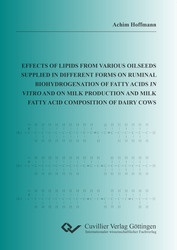| Departments | |
|---|---|
| Book Series (96) |
1378
|
| Nachhaltigkeit |
3
|
| Gesundheitswesen |
1
|
| Humanities |
2365
|
| Natural Sciences |
5406
|
| Mathematics | 229 |
| Informatics | 319 |
| Physics | 980 |
| Chemistry | 1363 |
| Geosciences | 131 |
| Human medicine | 243 |
| Stomatology | 10 |
| Veterinary medicine | 108 |
| Pharmacy | 147 |
| Biology | 835 |
| Biochemistry, molecular biology, gene technology | 121 |
| Biophysics | 25 |
| Domestic and nutritional science | 45 |
| Agricultural science | 1004 |
| Forest science | 201 |
| Horticultural science | 20 |
| Environmental research, ecology and landscape conservation | 148 |
| Engineering |
1793
|
| Common |
98
|
|
Leitlinien Unfallchirurgie
5. Auflage bestellen |
|
Advanced Search
Effects of lipids from various oilseeds supplied in different forms on ruminal biohydrogenation of fatty acids in vitro and on milk production and milk fatty acid composition of dairy cows (English shop)
Achim Hoffmann (Author)Preview
Table of Contents, PDF (73 KB)
Extract, PDF (360 KB)
Dietary lipid supplements in ruminant diets, whether from various natural sources or
supplements such as rumen protected lipids, have a long history and are widely used. The main reasons for using these supplements include an increased energy density of dairy cow diets, e.g. in the early stage of lactation (Clapperton and Steele, 1983). Moreover, reproductive parameters might are affected as well by using lipid supplements, either indirectly by changes in the energy balance of cows or directly due to the effects of certain fatty acids (FA) on reproductive organs and processes (Leroy et al., 2014).
| ISBN-13 (Hard Copy) | 9783736996434 |
| ISBN-13 (eBook) | 9783736986435 |
| Final Book Format | A5 |
| Language | English |
| Page Number | 142 |
| Edition | 1. |
| Publication Place | Göttingen |
| Place of Dissertation | Hohenheim |
| Publication Date | 2017-10-24 |
| General Categorization | Dissertation |
| Departments |
Agricultural science
Animal production |
| Keywords | Biohydrogenation, Milk Production, Milk Fatty Acid Composition, Strukturen von Fettsäuren |








